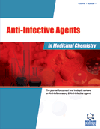- Home
- A-Z Publications
- Anti-Infective Agents in Medicinal Chemistry (Formerly Current Medicinal Chemistry - Anti-Infective Agents)
- Previous Issues
- Volume 6, Issue 1, 2007
Anti-Infective Agents in Medicinal Chemistry (Formerly Current Medicinal Chemistry - Anti-Infective Agents) - Volume 6, Issue 1, 2007
Volume 6, Issue 1, 2007
-
-
Editorial
More LessAuthors: Tarek S. Mansour and Phaik-Eng SumWe first would like to thank our new Advisory Board Members for their efforts in supporting the review of manuscripts. This aspect is much appreciated. The field of research on anti-infective agents and new targets has shown strong progress on many fronts targeted towards antibacterial, antifungal and antiviral agents. Most notably are the advances in the discovery and clinical development of inhibitors of he Read More
-
-
-
Unique Applications of Novel Antifungal Drug Combinations
More LessAuthors: Chiatogu Onyewu and Joseph HeitmanCandida albicans is a commensal fungal organism that can over-proliferate and cause disease in the appropriate host setting. C. albicans can cause irritating superficial skin and mucocutaneous infections such as diaper rash and vaginal yeast infections, respectively. In immunocompromised hosts, these infections can progress to disseminated disease in which the organism enters the blood and colonizes multiple organs. Cons Read More
-
-
-
Recent Synthesis of Marine Natural Products with Antibacterial Activities
More LessAuthors: Ines Mancini, Andrea Defant and Graziano GuellaThe emergence of multiple-drug-resistant strains of bacteria, the indiscriminate use of antibiotics and the increasing susceptibility of individuals with acquired immunodeficiency syndrome (AIDS) to infection from Mycobacterium induce an urgent need for development of new strategies to treat bacterial infections. Many natural products from marine sources are endowed with promising antibacterial activities, thus represen Read More
-
-
-
Activities of Quinolones Against Obligately Anaerobic Bacteria
More LessAuthors: R. Schaumann and A. C. RodloffQuinolones are of clinical and scientific interest since their discovery based on the nalidixic acid in the early 1960s. They are based on two types of ring structures, the quinolone nucleus and the naphthyridone nucleus. Nalidixic acid as the first discovered agent is a naphthyridone and has only a moderate activity against Gram-negative rods. The modification of the quinolone and naphthyridone structures resulted in increasing ac Read More
-
-
-
Mechanism of Action and Potential for Use of Tea Catechin as an Antiinfective Agent
More LessAuthors: Tadakatsu Shimamura, Wei-Hua Zhao and Zhi-Qing Hu“Drinking several cups of green tea a day keeps the doctor away” is clearly an overstatement. However, extensive research has revealed that the predominant catechin from tea (Camellia sinensis), epigallocatechin gallate (EGCg), has significant medicinal and health-promoting properties. This review summarizes what is presently known about the antimicrobial properties of EGCg, with a particular focus on the synergistic relatio Read More
-
-
-
The First Years of Linezolid Experience in Clinical Practice: A Balance and Future Implications
More LessAuthors: Roberto Manfredi and Leonardo CalzaMulti-antibiotic resistant Gram-positive cocci, which include Staphylococcus aureus, the coagulase-negative staphylococcal group, Enterococcus faecalis and Enterococcus faecium, and other streptococci, represent emerging pathogens especially in the setting of the immunocompromised, hospitalized patients, in particular when surgery, invasive procedures, or prosthetic implants are of concern, patients are admitted in int Read More
-
-
-
Extended-Spectrum Cephalosporinases in Enterobacteriaceae
More LessAuthors: Hedi Mammeri and Patrice NordmannExtended-spectrum AmpC β-lactamases are derived from chromosomal cephalosporinases by amino acid deletion, insertion and replacement. These structural changes are responsible for an increased catalytic efficiency against extended- spectrum cephalosporins, such as ceftazidime, cefotaxime, cefepime, and cefpirome. An overview of the molecular and biochemical characterization of these identified β-lactamases i Read More
-
Most Read This Month
Article
content/journals/aiamc
Journal
10
5
false
en


